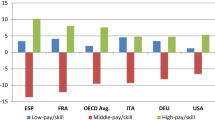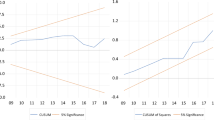Abstract
Building on the canonical model of skill-biased technical change to incorporate differential effects of technology and international trade on the skill composition of occupations, the paper employs a task-based approach to analyze structural changes in regional employment within a rich vocational education setting in West Germany during 1979 and 2012. Results confirm theoretical predictions that regional employment districts with high initial share of routine occupations have experienced greater subsequent adoption of computer and information technology and larger decline in routine occupations. Exposure to global imports in goods and services has reduced overall employment in routine-intensive occupations; the magnitude being notably smaller as compared to technology. However, when looking at the direction of displacement of routine workers, regions with greater share of routine jobs have experienced greater growth of high-skilled abstract jobs in the subsequent periods while the overlap between initial apprenticeship intensity and subsequent decline in regional routine employment is significantly strong. Taken together, findings show that unlike in the USA where employment growth in low-skilled service occupations has been the greatest, in Germany there is a greater trend toward occupational upgrading and larger growth in managerial and professional occupations due to the operationalization of its apprenticeship system.

Source: Authors’ own calculation

Source: United Nations Comtrade Database

Source: Federal Statistical Office

Source: Authors’ own calculation
Similar content being viewed by others
Notes
See Fig. 5 in Appendix for apprenticeship contracts for each time period.
One reason for this observation could be multicollinearity, following which we have provided alternate specifications in the Appendix where all variables of interest are included separately in subsequent models.
References
Abel, J.R., and R. Deitz. 2011. Do colleges and universities increase their region’s human capital? Journal of Economic Geography 12 (3): 667–691.
Acemoglu, Daron, and Autor, David. 2012. What does human capital do? A review of Goldin and Katz’s the race between education and technology. No. w17820. National Bureau of Economic Research.
Acemoglu, D. 1998. Changes in unemployment and wage inequality: An alternative theory and some evidence. (No. w6658). National Bureau of Economic Research.
Akcomak, S., S. Kok, and Rojas-Romagosa, H. 2013. The effects of technology and offshoring on changes in employment and task-content of occupations. (No. 233). CPB Netherlands Bureau for Economic Policy Analysis.
Amin, A., and N. Thrift. 1995. Globalization, institutions, and regional development in Europe. Oxford: Oxford University Press.
Antonczyk, D., T. DeLeire, and Fitzenberger, B. 2010. Polarization and rising wage inequality: Comparing the US and Germany. ZEW-Centre for European economic research discussion paper (10-015).
Autor, D., L.F. Katz, and A.B. Krueger. 1998. Computing inequality: Have computers changed the labor market? Quarterly Journal of Economics 113 (4): 1169–1213.
Autor, D., L.F. Katz, and M.S. Kearney. 2008. Trends in US wage inequality: Revising the revisionists. The Review of Economics and Statistics 90 (2): 300–323.
Autor, D., D. Dorn, and Hanson, G. 2013. The China syndrome: Local labour market effects of import competition in the United States. American Economic Review 103 (6): 2121–2168.
Autor, D.H., and D. Dorn. 2013. The growth of low skill service jobs and the polarization of the US labour market. American Economic Review 103 (5): 1553–1597.
Autor, D.H., F. Levy, and R.J. Murnane. 2003. The skill content of recent technological change: An empirical exploration. The Quarterly Journal of Economics 118: 1279–1333.
Autor, D. 2013. The task-approach to labor markets: An Overview. Journal of Labor Market Research 46 (3): 185–199.
Baldwin, R. 2011. Trade and industrialisation after globalisation’s 2nd unbundling: How building and joining a supply chain are different and why it matters. National Bureau of Economic Research.
Berman, E., J. Bound, Z. Griliches, and S. Machin. 1998. Implications of skill-biased technical change: international evidence. The Quarterly Journal of Economics 113: 1245–1279.
BIBB Vocational Education and Training VET report. 2013. https://datenreport.bibb.de/html/5679.htm
Blinder, A.S. 2009. How many US jobs might be offshorable? World Economics 10 (2): 41–78.
Bloom, N., M. Draca, and J. Van Reenen. 2013. Trade induced technical change? The impact of Chinese imports on innovation, IT, and productivity. Mimeo: Stanford University.
Card, D., and A.B. Krueger. 1995. Time-series minimum-wage studies: a meta-analysis. The American Economic Review 85: 238–243.
Card, D., and J.E. DiNardo. 2002. Skill biased technological change and rising wage inequality: some problems and puzzles. (No. w8769). National Bureau of Economic Research.
David, A., D. Dorn, and Hanson, G.H. 2014. The geography of trade and technology shocks in the United States. (No. w18940). National Bureau of Economic Research.
Diamond, C.A., and C.J. Simon. 1990. Industrial specialization and the returns to labor. Journal of Labor Economics 8: 175–201.
Faini, R. 1999. Trade unions and regional development. European Economic Review 43 (2): 457–474.
Florida, R., C. Mellander, K. Stolarick, and A. Ross. 2011. Cities, skills and wages. Journal of Economic Geography 12 (2): 355–377.
Frenken, K., F. Van Oort, and T. Verburg. 2007. Related variety, unrelated variety and regional economic growth. Regional Studies 41 (5): 685–697.
Glaeser, E.L., G.A. Ponzetto, and K. Tobio. 2014. Cities, skills and regional change. Regional Studies 48 (1): 7–43.
Goldin, Claudia Dale, and Lawrence F. Katz. 2009. The race between education and technology. Cambridge: Harvard University Press.
Goos, M., A. Manning, and A. Salomons. 2009. The polarization of the European labor market. American Economic Review Papers and Proceedings 99 (2): 58–63.
Goos, M., and A. Manning. 2007. Lousy and lovely jobs: The rising polarization of work in Britain. The Review of Economics and Statistics 89 (1): 118–133.
Katz, L.F., and K.M. Murphy. 1992. Changes in relative wages, 1963–1987: Supply and demand factors. The Quarterly Journal of Economics 107 (1): 35–78.
Krueger, A. 1992. How computers have changed the wage structure, a paraitre dans. Quarterly Journal of Economics 108: 33–60.
Krugman, P.R. 1991. Geography and trade. Cambridge: MIT press.
Krusell, Per, Lee E. Ohanian, Jose-Victor Rios-Rull, and Giovanni L. Violante. 2000. Capital-skill complementarity and inequality: A macroeconomic analysis. Econometrica 68 (5): 1029–1053.
Levy, F., and R.J. Murnane. 1992. US earnings levels and earnings inequality: A review of recent trends and proposed explanations. Journal of Economic Literature 30: 1333–1381.
Lu, Y., and T. Ng. 2013. Import competition and skill content in US manufacturing industries. Review of Economics and Statistics 95 (4): 1404–1417.
Mameli, F., S. Iammarino, and Boschma, R. 2012. Regional variety and employment growth in Italian labour market areas: services versus manufacturing industries.
Moretti, E. 2004. Human capital externalities in cities. Handbook of Regional and Urban Economics 4: 2243–2291.
Moretti, E. 2010. Local multipliers. The American Economic Review 100: 373–377.
Pierce, J.R., and P.K. Schott. 2012. The surprisingly swift decline of US manufacturing employment. American Economic Review 106: 1632–1662.
Rendall, M., and F.J. Weiss. 2014. Employment polarization and the role of the apprenticeship system. Working Paper (10). University of Zurich, UBS International Center of Economics in Society
Spitz-Oener, A. 2006. Technical change, job tasks, and rising educational demands: looking outside the wage structure. Journal of Labor Economics 24 (2): 235–270.
Senftleben, C., and H. Wielandt. 2013. The polarization of employment in German local labor markets (No. 2012-013). SFB 649 discussion paper.
Scott, A.J. 2010. Space time variations of human capital assets across US metropolitan areas, 1980 to 2000. Economic Geography 86 (3): 233–250.
Tinbergen, J. 1974. Substitution of graduate by other labor. Kyklos 27: 217–226.
Tinbergen, J. 1975. Income difference: Recent research. Amsterdam: North-Holland Publishing Company.
Verhoogen, E. 2008. Trade, quality upgrading and wage inequality in the Mexican manufacturing sector. The Quarterly Journal of Economics 123 (2): 489–530.
Winters, J.V. 2013. Human capital externalities and employment differences across metropolitan areas of the USA. Journal of Economic Geography 13 (5): 799–822.
Acknowledgements
Preliminary versions of the manuscript have been presented in DRUID Winter Conference Aalborg 2015 and Jena Economic Research Workshop 2015, and the comments and suggestions received in each of them are strongly acknowledged. Critical yet insightful discussions with Davide Consoli and Uwe Cantner have helped a great deal in formalizing the theoretical arguments. The Institute for Employment Research (IAB) and the Cornell Restricted Access Data Center (CRADC) also deserve special mention for providing remote access to their data and prompt response in processing the program les. This research has been financially supported by the Deutsche Forschungsgemeinschaft (DFG) and the Research Training Group 1411 “The Economics of Innovative Change.”
Author information
Authors and Affiliations
Corresponding author
Rights and permissions
About this article
Cite this article
Roy, I., Consoli, D. Employment Polarization in Germany: Role of Technology, Trade and Human Capital. Ind. J. Labour Econ. 61, 251–279 (2018). https://doi.org/10.1007/s41027-018-0133-4
Published:
Issue Date:
DOI: https://doi.org/10.1007/s41027-018-0133-4
Keywords
- Skill-biased technical change
- Task-based approach
- Skill composition
- Technology
- International trade
- Apprenticeship
- Regional employment districts






